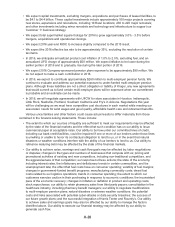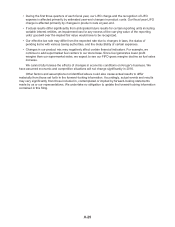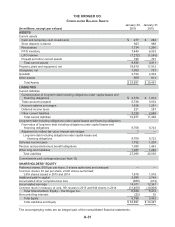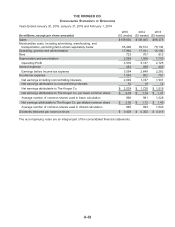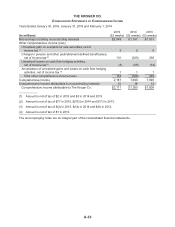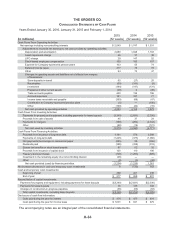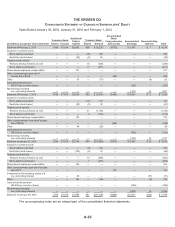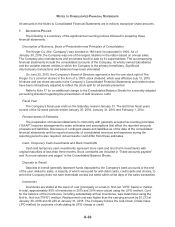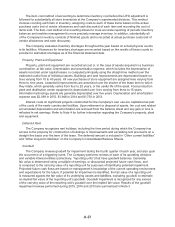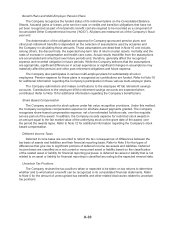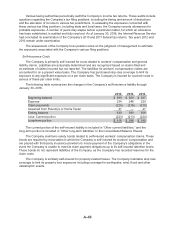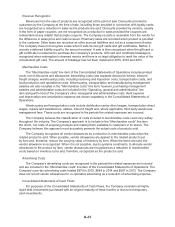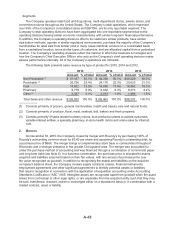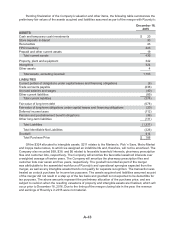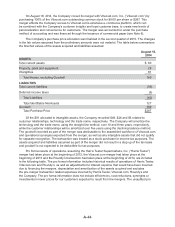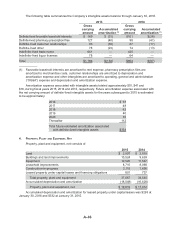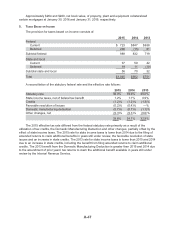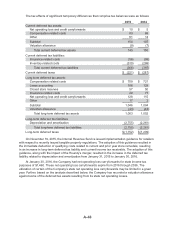Kroger 2015 Annual Report Download - page 112
Download and view the complete annual report
Please find page 112 of the 2015 Kroger annual report below. You can navigate through the pages in the report by either clicking on the pages listed below, or by using the keyword search tool below to find specific information within the annual report.A-38
Impairment of Long-Lived Assets
The Company monitors the carrying value of long-lived assets for potential impairment each quarter
based on whether certain triggering events have occurred. These events include current period losses
combined with a history of losses or a projection of continuing losses or a significant decrease in the market
value of an asset. When a triggering event occurs, an impairment calculation is performed, comparing
projected undiscounted future cash flows, utilizing current cash flow information and expected growth
rates related to specific stores, to the carrying value for those stores. If the Company identifies impairment
for long-lived assets to be held and used, the Company compares the assets’ current carrying value to
the assets’ fair value. Fair value is based on current market values or discounted future cash flows. The
Company records impairment when the carrying value exceeds fair market value. With respect to owned
property and equipment held for disposal, the value of the property and equipment is adjusted to reflect
recoverable values based on previous efforts to dispose of similar assets and current economic conditions.
Impairment is recognized for the excess of the carrying value over the estimated fair market value, reduced
by estimated direct costs of disposal. The Company recorded asset impairments in the normal course of
business totaling $46, $37 and $39 in 2015, 2014 and 2013, respectively. Costs to reduce the carrying value
of long-lived assets for each of the years presented have been included in the Consolidated Statements of
Operations as “Operating, general and administrative” expense.
Store Closing Costs
The Company provides for closed store liabilities relating to the present value of the estimated
remaining non-cancellable lease payments after the closing date, net of estimated subtenant income.
The Company estimates the net lease liabilities using a discount rate to calculate the present value of the
remaining net rent payments on closed stores. The closed store lease liabilities usually are paid over the
lease terms associated with the closed stores, which generally have remaining terms ranging from one to
20 years. Adjustments to closed store liabilities primarily relate to changes in subtenant income and actual
exit costs differing from original estimates. Adjustments are made for changes in estimates in the period
in which the change becomes known. Store closing liabilities are reviewed quarterly to ensure that any
accrued amount that is not a sufficient estimate of future costs is adjusted to income in the proper period.
Owned stores held for disposal are reduced to their estimated net realizable value. Costs to
reduce the carrying values of property, equipment and leasehold improvements are accounted for in
accordance with the Company’s policy on impairment of long-lived assets. Inventory write-downs, if
any, in connection with store closings, are classified in the Consolidated Statements of Operations as
“Merchandise costs.” Costs to transfer inventory and equipment from closed stores are expensed as
incurred.
The current portion of the future lease obligations of stores is included in “Other current liabilities,”
and the long-term portion is included in “Other long-term liabilities” in the Consolidated Balance Sheets.
Interest Rate Risk Management
The Company uses derivative instruments primarily to manage its exposure to changes in interest
rates. The Company’s current program relative to interest rate protection and the methods by which the
Company accounts for its derivative instruments are described in Note 7.
Commodity Price Protection
The Company enters into purchase commitments for various resources, including raw materials
utilized in its food production plants and energy to be used in its stores, food production plants and
administrative offices. The Company enters into commitments expecting to take delivery of and to utilize
those resources in the conduct of the normal course of business. The Company’s current program
relative to commodity price protection and the methods by which the Company accounts for its purchase
commitments are described in Note 7.


